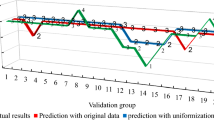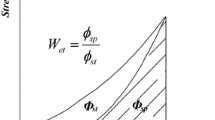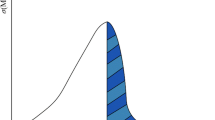Abstract
The serious consequences of rockburst have forced researchers to investigate alternatives methods for prediction. A lot of researches about rockburst resided in the focus on burst liability which is identified as an inherent cause of the rockburst. Due to the complex and highly nonlinear relationship between the impact factors and rockburst liability, traditional evaluation approaches are hard to gain ideal results for burst liability evaluation. A lot of scholars have tried to use machine learning to evaluate burst liability, but the results have been inconsistent. This study compares two fundamental machine learning models: discriminative and generative, which are typified by a support vector machine and Gaussian process classifier respectively, based on a uniform training dataset. This study also indicated burst liability evaluation is an unequal cost multi-class classification task in terms of machine learning. In addition to a conventional performance metric, the receiver operating curve (ROC) is generalized to evaluate model performances for this kind of task. The results indicate that the discriminative approach is more suitable for burst liability evaluation problem considering a common problem in burst liability evaluation task which is the sample size is limited. Finally, this conclusion was furtherly verified by a real rockburst case at a diamond mine.




Similar content being viewed by others
References
Adoko, A. C., Gokceoglu, C., Wu, L., & Zuo, Q. J. (2013). Knowledge-based and data-driven fuzzy modeling for rockburst prediction. International Journal of Rock Mechanics and Mining Sciences, 61, 86–95.
Baltz, R., & Hucke, A. (2008). Rockburst prevention in the German coal industry. Proceedings of the 27th International Conference on Ground Control in Mining (pp. 46–50). Morgantown: West Virginia University.
Blake, W., & Hedley, D. G. (2003). Rockbursts: Case studies from North American hard-rock mines. Littleton: SME.
Boser, B. E., Guyon, I. M., & Vapnik, V. N. (1992). A training algorithm for optimal margin classifiers. Proceedings of the 5th Annual Workshop on Computational Learning Theory (pp. 144–152). ACM.
Butt, S. D., Apel, D. B., & Calder, P. N. (1997). Analysis of high frequency microseismicity recorded at an underground hardrock mine. Pure and Applied Geophysics, 150, 693–704.
Cai, W., Dou, L., Si, G., Cao, A., He, J., & Liu, S. (2016). A principal component analysis/fuzzy comprehensive evaluation model for coal burst liability assessment. International Journal of Rock Mechanics and Mining Sciences, 81, 62–69. https://doi.org/10.1016/j.ijrmms.2015.09.028.
Cortes, C., & Vapnik, V. (1995). Support-vector networks. Machine Learning, 20, 273–297.
Fajklewicz, Z. (1988). Application of microgravimetry method to detection of subsurface cavities and prediction of rock bursts. In Advances in coal geophysics (pp. 1–11). EAG, Hyderbad, India.
Feng, X., & Wang, L. (1994). Rockburst prediction based on neural networks. Transactions of Nonferrous Metals Society of China, 4, 7–14.
Frid, V. (1997). Rockburst hazard forecast by electromagnetic radiation excited by rock fracture. Rock Mechanics and Rock Engineering, 30, 229–236.
Hong-Bo, Z. (2005). Classification of rockburst using support vector machine. Rock and Soil Mechanics, 26, 642–644.
Iannacchione, A. T., & Zelanko, J. C. (1900). Occurrence and remediation of coal mine bumps: A historical review. U.S. Department of the Interior, Bureau of Mines. Special Publication 01-95, NTIS No. PB95-211967, 1995, pp. 27–67.
Kidybiński, A. (1981). Bursting liability indices of coal. International Journal of Rock Mechanics and Mining Sciences & Geomechanics Abstracts, Elsevier, 4, 295–304.
Korzeniowski, W., Skrzypkowski, K., & Zagórski, K. (2017). Reinforcement of underground excavation with expansion shell rock bolt equipped with deformable component. Studia Geotechnica et Mechanica, 39, 39–52.
Li, S. L. (2000). Study on rockburst proneness and strata control technology for deep mines with hard rock. Ph.D. Thesis, Northeastern University
Li, Z., Dou, L., Cai, W., Wang, G., He, J., Gong, S., et al. (2014). Investigation and analysis of the rock burst mechanism induced within fault–pillars. International Journal of Rock Mechanics and Mining Sciences, 70, 192–200. https://doi.org/10.1016/j.ijrmms.2014.03.014.
Mitri, H. S., Tang, B., & Simon, R. (1999). FE modelling of mining-induced energy release and storage rates. Journal of the Southern African Institute of Mining and Metallurgy, 99, 103–110.
Pedregosa, F., et al. (2011). Scikit-learn: Machine learning in Python. Journal of machine learning research, 12, 2825–2830.
Potvin, Y., Hudyma, M., & Jewell, R. J. (2000). Rockburst and seismic activity in underground Australian mines-an introduction to a new research project. ISRM International Symposium, International Society for Rock Mechanics.
Pu, Y., Apel, D. B., & Lingga, B. (2018a). Rockburst prediction in kimberlite using decision tree with incomplete data. Journal of Sustainable Mining, 17, 158–165.
Pu, Y., Apel, D. B., Wang, C., & Wilson, B. (2018b). Evaluation of burst liability in kimberlite using support vector machine. Acta Geophysica, 66(5), 973–982.
Pu, Y., Apel, D., & Xu, H. (2018c). A Principal Component Analysis/Fuzzy Comprehensive Evaluation for Rockburst Potential in Kimberlite. Pure and Applied Geophysics, 175(6), 2141–2151.
Rasmussen, C. E., & Williams, C. K. (2006). Gaussian processes for machine learning (Vol. 2, p. 4). the MIT Press
Richard, S. (1999). Analysis of fault-slip mechanisms in hard rock mining. Doctoral Thesis, McGill University.
Skrzypkowski, K. (2018). A new design of support for burst-prone rock mass in underground ore mining. E3S Web of Conferences, EDP Sciences, p. 00006
Spackman, K. A. (1989). Signal detection theory: Valuable tools for evaluating inductive learning. Proceedings of the 6th International Workshop on Machine Learning (pp. 160–163), Amsterdam, Elsevier.
Su, G.-S., Zhang, X.-F., & Yan, L.-B. (2008). Rockburst prediction method based on case reasoning pattern recognition. Journal of Mining & Safety Engineering, 1, 015.
Sun, J., Wang, L., Zhang, H., & Shen, Y. (2009). Application of fuzzy neural network in predicting the risk of rock burst. Procedia Earth and Planetary Science, 1, 536–543.
Tang, S., Wu, Z., & Chen, X. (2003). Approach to occurrence and mechanism of rockburst in deep underground mines. Chinese Journal of Rock Mechanics and Engineering, 8, 004.
Wang, J., Chen, J., Yang, J., & Que, J. (2009). Method of distance discriminant analysis for determination of classification of rockburst. Rock and Soil Mechanics, 30, 2203–2208.
Wang, Y., Li, W., Li, Q., Xu, Y., & Tan, G. (1998). Method of fuzzy comprehensive evaluations for rockburst prediction. Chinese Journal of Rock Mechanics and Engineering, 17, 493–501.
Wang, C., Xu, J., Zhao, X., & Wei, M. (2012). Fractal characteristics and its application in electromagnetic radiation signals during fracturing of coal or rock. International Journal of Mining Science and Technology, 22, 255–258.
Wang, J., & Zhang, J. (2010). Preliminary engineering application of microseismic monitoring technique to rockburst prediction in tunneling of **** II project. Journal of Rock Mechanics and Geotechnical Engineering, 2, 193–208.
Wattimena, R. K., Sirait, B., Widodo, N. P., & Matsui, K. (2012). Evaluation of rockburst potential in a cut-and-fill mine using energy balance. International Journal of the JCRM, 8, 19–23.
Wu, T.-F., Lin, C.-J., & Weng, R. C. (2004). Probability estimates for multi-class classification by pairwise coupling. Journal of Machine Learning Research, 5, 975–1005.
Wu, Y., & Zhang, W. (1997). Evaluation of the bursting proneness of coal by means of its failure duration. In S. J. Gibowicz & S. Lasocki (Eds.), Rockbursts and seismicity in mines (pp. 285–288). Rotterdam: Balkema.
**e, H., & Pariseau, W. G. (1993). Fractal character and mechanism of rock bursts. International Journal of Rock Mechanics and Mining Sciences & Geomechanics Abstracts, Elsevier, 4, 343–350.
Xu, M., Du, Z., Yao, G., & Liu, Z. (2008). Rockburst prediction of chengchao iron mine during deep mining. Chinese Journal of Rock Mechanics and Engineering, 27, 2921–2928.
Yang, J., Li, X., Zhou, Z., & Lin, Y. (2010). A fuzzy assessment method of rock-burst prediction based on rough set theory. **shu Kuangshan/Metal Mine, 6, 26–29.
Yi, Y., Cao, P., & Pu, C. (2010). Multi-factorial comprehensive estimation for **chuan’s deep typical rockburst tendency Keji Daobao. Science & Technology Review, 28, 76–80.
Zhang, L., & Li, C. (2009). Study on tendency analysis of rockburst and comprehensive prediction of different types of surrounding rock. In Controlling seismic hazard and sustainable development of deep mines (Vol. 2).
Zhang, L.-W., Zhang, D.-Y., Li, S.-C., & Qiu, D.-H. (2012). Application of RBF neural network to rockburst prediction based on rough set theory. Rock and Soil Mechanics, 33, 270–276.
Zhang, L. W., Zhang, D. Y., & Qiu, D. H. (2010). Application of extension evaluation method in rockburst prediction based on rough set theory. Journal of China Coal Society, 35(9), 1461–1465.
Zhang, C., Zhou, H., & Feng, X.-T. (2011). An index for estimating the stability of brittle surrounding rock mass: FAI and its engineering application. Rock Mechanics and Rock Engineering, 44, 401.
Zhou, J., Li, X., & Mitri, H. S. (2016). Classification of rockburst in underground projects: Comparison of ten supervised learning methods. Journal of Computing in Civil Engineering, 30, 04016003.
Zhou, J., Li, X., & Shi, X. (2012). Long-term prediction model of rockburst in underground openings using heuristic algorithms and support vector machines. Safety Science, 50, 629–644. https://doi.org/10.1016/j.ssci.2011.08.065.
Acknowledgements
This study was supported by the Natural Sciences and Engineering Research Council of Canada (NSERC) under Collaborative Research and Development (CRD) Grant. Supports from Chinese Scholarship Council are gratefully acknowledged.
Author information
Authors and Affiliations
Corresponding author
Additional information
Publisher's Note
Springer Nature remains neutral with regard to jurisdictional claims in published maps and institutional affiliations.
Rights and permissions
About this article
Cite this article
Pu, Y., Apel, D.B. & Wei, C. Applying Machine Learning Approaches to Evaluating Rockburst Liability: A Comparation of Generative and Discriminative Models. Pure Appl. Geophys. 176, 4503–4517 (2019). https://doi.org/10.1007/s00024-019-02197-1
Received:
Revised:
Accepted:
Published:
Issue Date:
DOI: https://doi.org/10.1007/s00024-019-02197-1




